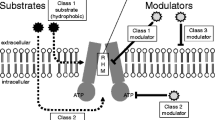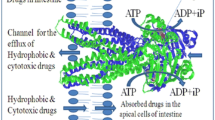Abstract
The objective was to directly compare the four different “calculation” methods of assessing P-gp inhibition potential using experimental data obtained from ~60 structurally diverse internal research and marketed compounds. Bidirectional studies for digoxin (probe for P-gp substrate) were performed with and without test compounds (at 10 μM). Four different calculation methods were applied to the same dataset (raw bidirectional permeability values) to obtain the “percent inhibition of P-gp” for these compounds using the different methods. Significantly different inhibition potential was obtained with the “exact” same experimental dataset depending on the calculation method used. Subsequently, entirely different conclusions regarding the “inhibition potential” of test compound was reached due to the different calculation methods. Based on the direct comparison of these methods, method no. 3 (i.e., inhibition of B to A permeability of digoxin) is recommended as the calculation method ideal during screening stages due to its high throughput amenability. The methodology is capable of rapidly screening compounds with adequate reliability for early stage drug discovery. Method no. 3 provides an abridged version of a bidirectional study that is fully capable of identifying all non-inhibitors (0–20%), moderate inhibitors (20–60%), and potent inhibitors (>60%) and demonstrates high correlation with method no. 1 (inhibition based on both A to B and B to A permeability of digoxin). Nevertheless, method no. 1 might be appropriate for more detailed mechanistic studies required in late stage discovery and development.



Similar content being viewed by others
Abbreviations
- A to B:
-
Apical to basolateral
- ADME:
-
Absorption, distribution, metabolism, elimination
- B to A:
-
Basolateral to apical
- BCRP:
-
Breast cancer resistance protein
- CNS:
-
Central nervous system
- FDA:
-
Food and drug administration
- HBSS:
-
Hank’s balanced salt solution
- HEPES:
-
N-2-hydroxyethylpiperazine-N′-2-ethanesulfonic acid
- LSC:
-
Liquid scintillation counting
- MDCK:
-
Mardin Darby canine kidney
- MRP:
-
Multi-drug resistance protein
- PAMPA:
-
Parallel artificial membrane permeability assay
- P-gp:
-
P-glycoprotein
- Pc:
-
Permeability coefficient
- TEER:
-
Transepithelial electrical resistance
References
E. Leahey, et al. Interaction between quinidine and digoxin. JAMA. 240:533–534 (1978).
J. Lin. Drug–drug interaction mediated by inhibition and induction of P-glycoprotein. Adv. Drug Deliv. Rev. 55:53–81 (2003).
J. Lin, and M. Yamazaki. Role of P-glycoprotein in pharmacokinetics. Clin Pharmacokinet. 42:59–98 (2003).
C. Matheny, M. Lamb, K. Brouwer, and G. Pollak. Pharmacokinetic and pharmacodynamic implications of P-gp modulation. Pharmacotherapy. 21:778–796 (2001).
J. Polli, et al. Role of P-gp on CNS disposition of amprenavir, an HIV protease inhibitor. Pharm. Res. 16:1206–1212 (1999).
J. W. Polli, et al. P-glycoprotein influences the brain concentrations of cetirizine (Zyrtec), a second-generation non-sedating antihistamine. J. Pharm. Sci. 92:2082–2089 (2003).
A. Sparreboom, et al. Limited oral bioavailability and active epithelial excretion of paclitaxel (Taxol) caused by P-gp in the intestine. Proc. Natl. Acad. Sci. 94:2031–2035 (1997).
T. Watanabe, et al. Kinetic analysis of hepatobiliary transport of vincristine in perfused rat liver: Possible roles of P-gp in biliary excretion of vincristine. J. Hepatol. 16:77–88 (1992).
FDA Draft Guidance. Drug interaction studies—Study design, data analysis, and implications for dosing and labeling. 2006.
P. V. Balimane, Y. H. Han, and S. Chong. Current industrial practices of assessing permeability and P-glycoprotein interaction. AAPS J. 8:E1–13 (2006).
L. Cutler, C. Howes, N. J. Deeks, T. L. Buck, and P. Jeffrey. Development of a P-glycoprotein knockout model in rodents to define species differences in its functional effect at the blood-brain barrier. J. Pharm. Sci. 95:1944–1953 (2006).
B. Feng, et al. In vitro p-glycoprotein assays to predict the in vivo interactions of p-glycoprotein with drugs in the central nervous system. Drug. Metab. Dispos. 36:268–275 (2008).
I. Hidalgo. Assessing the absorption of new pharmaceuticals. Current Topics in Medicinal Chemistry. 1:385–401 (2001).
J. P. Keogh, and J. R. Kunta. Development, validation and utility of an in vitro technique for assessment of potential clinical drug–drug interactions involving P-glycoprotein. Eur. J. Pharm. Sci. 27:543–554 (2006).
E. Kerns, et al. Combined application of parallel artificial membrane permeability assay and Caco-2 permeability assays in drug discovery. J. Pharm. Sci. 93:1440–1453 (2004).
J. Polli, et al. Rational use of in vitro P-gp assays in drug discovery. J. Pharmacol. Exp. Ther. 299:620–628 (2001).
J. Rautio, et al. In vitro p-glycoprotein inhibition assays for assessment of clinical drug interaction potential of new drug candidates: a recommendation for probe substrates. Drug Metab. Dispos. 34:786–792 (2006).
F. Tang, K. Horie, and R. Borchardt. Are MDCK cells transfected with the human MDR1 gene a good model of the human intestinal mucosa. Pharm. Res. 19:765–772 (2002).
A.-L. Ungell. Caco-2 replace or refine. Drug Discov. Today. 1:423–430 (2004).
P. Hsiao, T. Bui, R. J. Ho, and J. D. Unadkat. In vitro-to-in vivo prediction of P-glycoprotein-based drug interactions at the human and rodent blood–brain barrier. Drug. Metab. Dispos. 36:481–484 (2008).
R. Kim, et al. Interrelationship between substrates and inhibitors of human CYP3A and P-gp. Pharm. Res. 16:408–414 (1999).
M. Perloff, E. Stromer, L. von Moltke, and D. Greenblatt. Rapid assessment of P-gp inhibition and induction in vitro. Pharm. Res. 20:1177–1183 (2003).
M. D. Troutman, and D. R. Thakker. Efflux ratio cannot assess P-glycoprotein-mediated attenuation of absorptive transport: Asymmetric effect of P-glycoprotein on absorptive and secretory transport across Caco-2 cell monolayers. Pharm. Res. 20:1200–1209 (2003).
R. Stephens, et al. Kinetic profiling of P-gp mediated drug efflux in rat and human intestinal epithelia. J. Pharmacol. Exp. Ther. 296:584–591 (2001).
P. V. Balimane, and S. Chong. Cell culture-based models for intestinal permeability: A critique. Drug Discov. Today. 10:335–343 (2005).
P. V. Balimane, K. Patel, A. Marino, and S. Chong. Utility of 96 well Caco-2 cell system for increased throughput of P-gp screening in drug discovery. Eur. J. Pharm. Biopharm. 58:99–105 (2004).
Author information
Authors and Affiliations
Corresponding author
Rights and permissions
About this article
Cite this article
Balimane, P.V., Marino, A. & Chong, S. P-gp Inhibition Potential in Cell-Based Models: Which “Calculation” Method is the Most Accurate?. AAPS J 10, 577–586 (2008). https://doi.org/10.1208/s12248-008-9068-x
Received:
Accepted:
Published:
Issue Date:
DOI: https://doi.org/10.1208/s12248-008-9068-x




